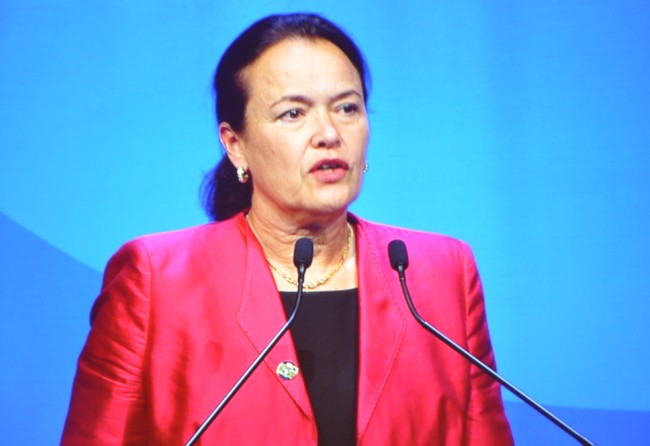2014年美国临床肿瘤学会年会已于当地时间5月30日-6月3日在芝加哥成功举行。会议期间公布了一些非常重要的临床试验的结果,其中“Plenary Session”的四项研究最受关注和期待。下面和大家分享其中一项III期ALTTO试验的首个结果,比较拉帕替尼单药治疗、曲妥珠单抗单药治疗、曲妥珠单抗→拉帕替尼序贯治疗和曲妥珠单抗+拉帕替尼联合辅助抗HER2治疗(1年)HER2阳性早期乳腺癌的疗效。
拉帕替尼是一种小分子酪氨酸激酶抑制剂。拉帕替尼和/或曲妥珠单抗最优化治疗(ALTTO)试验是一个随机、III期试验,比较了3种包含拉帕替尼的方案和曲妥珠单抗单药治疗的疗效,每种方案都作为HER2阳性早期乳腺癌的辅助治疗,应用一年。

研究者Edith A. Perez教授在全体大会上报告
研究方法
自2007年1月至2011年7月间,来自44个国家、946个研究中心的8381位患者被随机分配到曲妥珠单抗单药治疗组(N=2097)、拉帕替尼单药治疗组 (N=2100)、曲妥珠单抗→拉帕替尼序贯治疗组(N=2091)或曲妥珠单抗+拉帕替尼治疗组(N=2093)。在完成所有化疗后(设计1),同时应用紫杉烷、蒽环霉素(设计2)或同时应用不含蒽环霉素、含铂类的方案(设计2B)再开始进行抗HER2治疗。设计1中,曲妥珠单抗的首次给药剂量为8 mg/kg 静脉推注,随后应用6 mg/kg维持治疗,每3周一疗程,治疗52个周,或者应用拉帕替尼1500 mg/d,治疗52周,或者首次给予曲妥珠单抗4 mg/kg静脉推注,随后应用2 mg/kg维持治疗,1周1疗程,治疗12周,中间停药6周,随后应用拉帕替尼1500 mg/d,总共治疗34周;或者首次应用曲妥珠单抗8 mg/kg静脉推注,随后应用6 mg/kg维持治疗,每3周1疗程,同时应用拉帕替尼1000 mg/d,治疗52周。设计2中,每周应用紫杉醇80 mg/m2或75 mg/m2,同时每3周应用多西他赛联合治疗。在设计2B中,应用多西他赛 (75 mg/m2) +卡铂治疗6个疗程,同时联用抗HER2药物。曲妥珠单抗每周应用1次,在联合化疗时拉帕替尼减量。主要试验终点是无病生存期。1个中期分析显示拉帕替尼单药治疗的效果不如曲妥珠单抗单药治疗,根据独立数据监控委员会的推荐,拉帕替尼单药治疗组于2011年8月18日取消。
研究结果
计划中首次无病生存期分析的临床截止日期是2013年12月6日,预计获得草案时随访时间的中位数为4.5年。实际随访时间的中位数为4.5年,与曲妥珠单抗单药治疗相比,拉帕替尼+曲妥珠单抗序贯治疗或同时治疗,患者的无病生存事件的风险较低(无病生存事件是指浸润性乳腺癌复发,出现另一种原发性癌症或任何原因所致的死亡),但是差异没有显著性。三个治疗组患者的4年无病生存率相似,其中曲妥珠单抗组86%,拉帕替尼+曲妥珠单抗同时治疗组88%,序贯治疗组87%。
与曲妥珠单抗单药治疗相比,联合治疗的某些不良反应的发生率更高,例如腹泻、皮疹和肝病。该试验的另一个主要发现是,严重的心脏相关不良反应的发生率极低。ALTTO试验组中,充血性心力衰竭的发生率低于1%,即使95%的患者应用蒽环霉素化疗。
结论
与曲妥珠单抗单药治疗相比,拉帕替尼+曲妥珠单抗序贯治疗或同时治疗HER2阳性早期乳腺癌
没有明显的优势。治疗组患者的4年无病生存率相似。
作者观点
杰克逊维尔梅奥诊所的大型癌症中心副主任、研究的资深作者Edith A. Perez医生评论。看到大多数HER2阳性的早期乳腺癌患者都在应用标准曲妥珠单抗治疗,我们都很受鼓舞。但是令我们吃惊的是,在标准化疗方案中添加拉帕替尼不会改善患者的预后,因为在术前患者的小样本研究中发现这些药物联合很有希望。该试验的主要教训是,对于特殊的疾病,我们需要稳健的进行临床试验来充分的评估和理解新的治疗方案的价值。
研究的同时,我们还收集了大量的血液和组织样本,其可以帮助研究者们进一步理解乳腺癌的生物学特点,从而使大家理解为什么某些患者复发,而其他人没有复发。
在该研究以前还做过一个样本量更小的NeoALTTO试验,术前应用拉帕替尼和曲妥珠单抗联合治疗时患者的病理完全缓解(手术时没有浸润性乳腺癌或淋巴结转移的证据)率是曲妥珠单抗单药治疗时的两倍。然而,ALTTO试验并没有显示,与曲妥珠单抗单药抗HER2治疗相比,联合治疗不但可以提高乳腺癌的病理完全缓解率,还可以改善患者的远期预后。ALTTO试验将影响未来乳腺癌临床试验的设计,因为在比较两种治疗方案的疗效时,该试验对应用乳腺癌病理完全缓解率作为远期治疗效果的替代标志物产生了质疑。
ASCO观点
这些结果阐明了临床试验设计完好的重要性,美国临床肿瘤学会主席Clifford A. Hudis医生进行点评。既然如此,术前联合治疗时乳腺癌病理完全缓解率的增加并不代表患者的无病生存率的提高。其他试验应用不同的药物可以得出不同的结论,但是现在该试验确保了,曲妥珠单抗在辅助治疗HER2阳性乳腺癌时是安全有效的。
医脉通整理报道,转载请注明出处。
会议专题》》》2014年ASCO年会专题报道
阅读摘要原文
First results from the phase III ALTTO trial (BIG 2-06; NCCTG [Alliance] N063D) comparing one year of anti-HER2 therapy with lapatinib alone (L), trastuzumab alone (T), their sequence (T→L), or their combination (T+L) in the adjuvant treatment of HER2-positive early breast cancer (EBC).(Abstract #LBA4)
Background: Lapatinib (L) is a small molecule tyrosine kinase inhibitor. The Adjuvant Lapatinib and/or Trastuzumab Treatment Optimisation (ALTTO) Trial is a randomised, phase III trial comparing 3 orally L-containing regimens with T alone, each given for 1 year as adjuvant treatment for HER2-positive EBC.
Methods: From Jan 2007 to Jul 2011, 8381 patients (pts) were randomized from 946 participating sites in 44 countries to receive either T alone (N=2097), L alone (N=2100), T→L (N=2091), or T+L (N=2093). Anti-HER2 therapy was initiated after completion of all chemotherapy (Design 1), concomitantly with a taxane following anthracycline (Design 2), or concomitantly with a non-anthracycline, platinum-containing regimen (Design 2B). Dosing in Design 1 was T 8 mg/kg IV loading dose followed by 6 mg/kg IV q3 weeks for 52 weeks; or L 1500 mg/d for 52 weeks; or T 4 mg/kg IV loading dose followed by 2 mg/kg IV weekly for a total of 12 weeks followed by a 6-week treatment-free interval followed by L 1500 mg/d for a total of 34 weeks; or T 8 mg/kg IV loading dose followed by 6 mg/kg IV q3 weeks concomitant with L 1000 mg/d for 52 weeks. In Design 2, 80 mg/m2 weekly paclitaxel or 75 mg/m2 3-weekly docetaxel were administered concomitantly with the anti-HER2 agents. In Design 2B, 6 cycles of docetaxel (75 mg/m2) with carboplatin (AUC 6) were administered concomitantly with the anti-HER2 agents; T was administered weekly and L doses were reduced when combined with chemotherapy. The primary endpoint is disease-free survival (DFS). The L alone arm was closed on August 18, 2011, following Independent Data Monitoring Committee recommendation based on a planned interim analysis showing that L was unlikely to be non-inferior to T alone.
Results: The clinical cut-off date for the first planned DFS analysis was December 6, 2013, predicted to obtain a protocol-defined median follow-up of approximately 4.5 years.At a median follow-up of 4.5 years, treatment with lapatinib plus trastuzumab (either sequential or concurrent) was associated with a numerically lower risk of a disease-free survival event – defined as recurrence of invasive breast cancer, development of a second primary cancer, or death from any cause – compared to trastuzumab alone, but the finding was not statistically significant. The four-year disease-free survival rates were similar in the three treatment arms – 86 percent in the trastuzumab arm, 88 percent in the concurrent arm, and 87 percent in the sequential arm. Compared to trastuzumab alone, the combination treatment was associated with much higher rates of certain side effects, such as diarrhea, skin rash, and liver problems.
Another important finding from this trial was that the rates of serious heart-related side effects were very low. in ALTTO the rate of congestive heart failure was less than 1 percent, even though 95 percent of women received anthracycline chemotherapy.
The study was accompanied by a large collection of blood and tissue specimens that will help researchers further understand the biology of breast cancer and provide insight as to why certain patients experience a relapse and others do not.
Conclusions: Post-surgery (adjuvant) treatment using a combination of two HER2-targeted drugs – trastuzumab and lapatinib – is no more effective than standard treatment with trastuzumab alone for women with early HER2-positive breast cancer. In the study, researchers found no statistically significant differences between treatment arms in four-year disease-free survival, which ranged between 86 and 88 percent.
